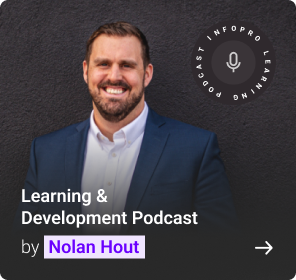Learning and Development (L&D) programs are essential to any organization that values the growth and development of its workforce. By equipping employees with the skills and knowledge needed to perform their jobs effectively, L&D initiatives can drive business success, increase employee satisfaction, and create a continuous learning and improvement culture. However, the success of any L&D program is ultimately determined by its impact. It is not enough to provide learning opportunities; organizations must be able to measure and demonstrate the impact of their L&D initiatives to ensure that they are delivering tangible benefits.
Unfortunately, measuring L&D impact can be challenging. Traditional learning metrics, such as completion rates and learner satisfaction surveys, only scratch the surface of what truly matters regarding impact. To prove the value of L&D programs, organizations must go beyond these surface-level metrics and dig deeper into the actual outcomes of their initiatives.
A 6-Step Strategy to Evaluate the Effectiveness of Your Organization’s L&D Efforts
Step 1: Aligning L&D with Business KPIs for Success
As a professional in employee training and development, adopting a strategic mindset beyond simply fulfilling orders is essential. It is equally important to communicate to employees that learning and development is not a mere event but a continuous process that impacts their job performance positively. This involves acquiring skills to manage and address variables that affect overall organizational performance.
To achieve this goal, a change in behavior and mindset is necessary to transform the L&D function into a strategic business aspect. Reflection on how L&D can contribute to business key performance indicators (KPIs) is crucial. The focus should be on how L&D can assist employees in enhancing their processes rather than solely on what they learned during a training program.
Step 2: Understanding the Real Problem at Hand
Demonstrating the value of generic content or eLearning resources to your business takes time and effort. Analyzing your context is necessary to establish the effectiveness of your digital learning solution. Start by identifying the problem that needs to be solved, then assess if your solution has achieved the intended impact. Understand your stakeholders’ objectives to align expectations and overcome business challenges.
By engaging stakeholders and collecting their training requests, you establish yourself as a competent leader and boost your confidence. Communicating with your audience helps you understand the factors to consider when addressing issues. This analysis assists in assessing the effectiveness of your digital learning resources and identifying areas for improvement. Engage subject-matter experts through comprehensive and active strategies, like task analysis, which involves learning through observation.
Step 3: Focus on the Performance Metrics
Relying solely on learning metrics like completion rates and satisfaction scores is inadequate since they only serve as indicators. A competent learning platform must facilitate and monitor these metrics with ease. As an accomplished digital learning strategist, your utmost priority should be gauging improvements in employee performance.
To demonstrate the L&D program’s impact within your organization, it’s crucial to understand your workforce’s current performance and the specific outcomes they are striving to achieve. More than simply providing generic knowledge and skills, you must focus on practically implementing these aspects. For example, by emphasizing the “how,” you can help employees generate optimal outcomes and accomplish their objectives in their unique contexts.
Step 4: Demonstrate How Actions are Driving Progress
To measure the effectiveness of your efforts, evaluate employee performance and assess their acquisition of new skills. Prioritize meaningful indicators and acknowledge challenges to showcase leadership in learning and development. After defining performance in Step 3, identify key metrics reflecting the impact of learning initiatives. According to LinkedIn’s 2023 Workplace Learning Report, aligning learning programs with business strategies is the top goal for L&D professionals this year. However, the metrics used to measure success often do not align with this goal. Commonly used metrics include employee satisfaction surveys, qualitative feedback, the number of completed courses per employee, and more.
Rather than just looking at completion or engagement rates, emphasizing these key performance indicators (KPIs) will draw the attention of revenue leaders, executives, and C-suite members. Demonstrating your understanding of these metrics can strengthen your position and contribute meaningfully to important discussions and decision-making processes.
Step 5: Earn the Trust of Your Stakeholders through Transparency and Agility
If your company decides to change the Learning Management System (LMS) or its suite of content, you can expect increased employee expectations. They will believe that this change will truly make a difference. However, more than simply making a change is required. It is important to remember that it leaves a remarkable impression when L&D leaders delve deeper than just engagement metrics. They need to truly comprehend the objectives that the teams are striving to achieve. Rapidly evolving skills require agile L&D processes and tools that keep pace with the company. Lean processes and cross-functional collaboration enable L&D teams to create minimum viable products (MVPs), test ideas, and iterate quickly.
Step 6: Involve Multiple Stakeholders in the Creation Process
As an L&D leader, understand and address learners’ needs by involving subject matter experts in content creation. Align employees with the organization’s purpose for increased engagement. Involve all stakeholders in the learning experience. Empower teams with collaborative content creation tools for effective knowledge sharing. Implement training through an LMS, bringing learners and training experts together.
Tailored learning content can be created and delivered by identified experts and supplemented by off-the-shelf resources. This approach allows individuals to prioritize learning needs and enables L&D teams to maximize employee growth. Align stakeholders and leverage subject matter experts to achieve cost savings, increase productivity, and upskill to meet evolving business needs.
Conclusion
Effective measurement and demonstration of the impact of L&D programs are crucial for driving business success. Organizations can maximize employee growth, engagement, and productivity by aligning L&D with business KPIs, focusing on performance metrics, and involving stakeholders in the creation process. Agility, transparency, and a strategic mindset are key to achieving impactful L&D initiatives. By implementing these 6 strategies, organizations can foster a continuous learning culture and meet evolving business needs, ultimately leading to cost savings and increased success.





